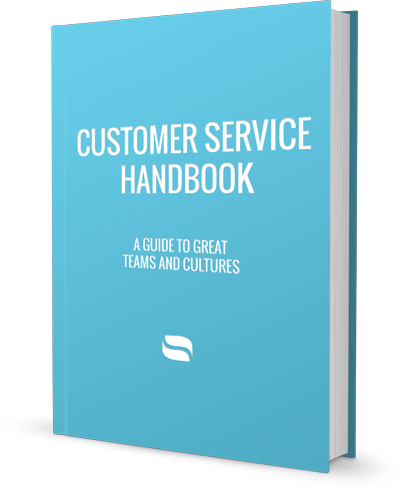







Starting Out
This is a part of a continuing series that is also available as a downloadable eBook here. We talked to 35 companies, including Stripe, Twilio, and Mailgun, to get a sense of what it takes to run a great customer support organization. While every company is different, there were some trends that we could identify as benchmarks for great customer support.
Defining Culture Early
Simply put, culture is just a set of commitments. And commitments are just sacrifices and compromises you're willing to make in exchange for a desired outcome. The earlier you establish commitments, the easier it will be to shape culture. The most typical causes for failed commitments are distractions, shifts in priorities, and the inability to balance available resources. Picking up commitments while your company is young and not overburdened with other hot-button issues can be a godsend. Identifying necessities and sacrifices is far more straightforward.
Culture is like a fast moving object. It has momentum. It's hard to change the direction of an object full of momentum. In contrast, an object with less momentum can easily change directions to find a more optimal path.
Stay Lean
You might have heard of the lean startup before. The same "less is more" and "rapid iteration" mentalities for product development can be applied to customer support as well. Because customer support is the side you show customers, you need the team to respond quickly to customer concerns, to communicate effectively to potentially thousands of customers in short time frames, and to delegate what customers need versus how other teams prioritize features. This requires you to think about customer support more as a product than simply just another internal process. Customer support is such a crucial extension for your business that it needs to remain agile and nimble.
Jason @ ideeli
"A lot of frustrations, both for agents and customers, come out of the fact you have to follow certain roles, rules, procedures, or policies that don't necessarily make sense because they were written either so long ago or because they are so far removed from what's actually important. If something doesn't make sense, there's no reason to keep doing it. We like to be agile in everything we do, including customer support"
There are many things you can do in the beginning to avoid accruing too much excess weight:
- Hire with caution. The biggest urge to overcome is to constantly hire new staff for customer support.
- No decisions are ever final. Customer sentiments change and you need all the flexibility you can muster to change with it.
- Don't commit to too much. This applies to both internal commitments as well as commitments to customers. Committing to too much is equivalent to not having a culture.
- Learn to say "NO". You simply can't agree and build everything. Just say "NO" in the right way.
- Everyone needs to be on the same level and page in order to be agile. Encourage your team to wear multiple hats and multitask.
- Don't over invest on tools. Heavy tools will only burden your team and skew your process in order to take advantage of those "features".
- Avoid figuring out every detail right now. Keep your options and thinking open.
Taylor @ Mailgun
"Even though we were consciously aware of this issue, we still did not limit our feature set enough. Early on it's really hard to say no - you are so grateful that someone is actually using your product and you want to please everyone. It takes a lot of discipline and the effect it has on your support and tech debt can be dramatic."
Leanness is a culture and deciding what's not a part of your culture is just as important as what is. Always make decisions that you'll eventually grow into without sacrificing what's working at the moment.
Picking A Tool To Start
If you're just starting out there are no better tools for us to recommend than email and phone. Email is flexible, adaptive, and still very professional. Email can also be very timely without getting you deep into the weeds of fancy features. It is still the most direct way of reaching your customers and the option that most people feel comfortable with. It's free (for the most part) and just about everyone has an email address. Email also has just about every auxiliary feature you need such as scheduling a meeting, sending an attachment, copying different people, forwarding, notifications, security, labeling, grouping into different folders, chat, etc.
Michael @ Stripe
"Given our team's growth, handling our email turned out to be an interesting decision of its own. Up until very recently, all email was handled through Gmail as we really wanted it to be people talking directly to us – not referencing a ticket number or being forced to reply above a certain line. We wanted to maintain these properties while having something that helped us understand all of the active conversations and distribute the work. We toyed around with hacks within Gmail (labels can be pretty flexible), but are now experimenting with other systems. It's necessary for us that, regardless of the tool we decide to use, we're not restricting our users from communicating with us however they're most comfortable."
Phone providers such as Google Voice and Skype are great tools that are free and flexible enough for you to adopt and discard as you move along. They're professional and won't cost you anything to try.
Rather than comparison shopping different customer service applications, start by thinking about how you want to interact with potential customers, through which primary channels, how intimate you want the conversation to be, and how you want customer support to represent your business. These are far more important concerns than which tools to buy.
Taylor @ Mailgun
"We focused on strong customer support from the beginning. We've always had a chat app on the website and we were very focused on response times to emails. In addition, we would offer personal phone and Skype contacts to customers - almost acting as pro bono email consultants."
Many will also tell you that you need a social network presence if you want to succeed. Perhaps a business page or an inbound handle of some sort will help. Not quite true for customer support. We're going to tell you to lay off on these matters when you're just setting up shop. Having a social network presence in the very beginning only compensates for the lack of a large marketing budget. You feel the urge to publicize yourself and find fans. If this is the case, treat this as community-building rather than customer support. Building your social network presence is an entirely different book. The simple fact is that not many customers will be reaching out to you through these channels for support related issues in the beginning and diverting too much attention away at this point can be counterproductive.
Instead, actively push customers to contact you directly via email. There are several notions you can establish with customers right off the bat:
- You are confident and not afraid to chat.
- You enjoy intimate conversations rather than quick bursts of sound bites.
- You are personally reachable and visible in a noiseless channel at all times.
- You are actively accountable and transparent.
- You take customer support seriously.
Who Does What?
Customer support is most genuine when you have a vested interest in making those who pay you happy. That's the simple answer. What you choose to do with that information is up to you. Based on our interviews with founders of rock star companies, 100 percent of them ran customer support themselves at some point. Customer support is, and always will be, the most direct way to gain insight into how customers are responding to your product. As founders, it's crucial to know who constitutes your customer base, how your product impacts customers on a day-to-day basis, what you're doing right and what you're doing wrong, and why some choose to come aboard while others choose to abandon ship.
Jason @ Twilio
"When the company first started out, there was no support team. Support was done by the founders, developers, and the developer evangelist team. Even now, every new employee that joins Twilio does a rotation in support. It doesn't matter what role they're going to play but they do their first two weeks as an integral part of the support team. That way, they get a better understanding of who the customers are, the kinds of problems they run into, as well as getting a deeper understanding of what the products are."
One thing to be wary of when you're starting out is to avoid assigning roles. Everyone should be doing customer support. If your team is small, make it a priority to level with everyone involved and get them on the same page with customer support. Their technical prowess and academic background is irrelevant. If anything, this is a great opportunity to cross train your teammates.
Michael @ Stripe
"We've held support at a high standard at Stripe since before we even had a name. Everyone at the company was hooked up to a Pager-Duty schedule so we'd be called whenever one of our users encountered an error; this offered us the flexibility to proactively reach out and make sure everyone was taken care of. Since then, we've continued trying solutions like the phone call rotation until they can't scale anymore. With our community chat, we would receive a phone call whenever someone went unanswered for a short period of time."
If you must put a number on it, we recommend choosing just one or two teammates to be on the starting lineup for customer support and talking to customers in a progressive manner. This person should be a multitasker and be willing to move in between teams. We'll dive into this topic in more detail later on in the book. This will:
- Keep the overall framework and structure for your support team lean and flexible.
- Limit excessive input into how a "team" should be run in the beginning.
- Concentrate and funnel customer feedback through just one or two people.
- Make delegating easier and more fluid.
- Make intra-company communication with customer support consistent and manageable.
Michael @ Stripe
"While we've grown from one to seven Stripes that work on support full-time, we have started learning how to efficiently scale a high-touch support experience. Part of this has been just with figuring out how best to allocate our resources; for example, we've recently changed how we triage incoming emails so that we're utilizing each person's expertise. It is paramount to us that any of our users be able to get in touch with a highly-skilled person."
Be Yourself
Do you enjoy talking to robots? What about seeing templatized responses that are immediately recognizable and ignorable? Customer support is and should be simple: having a close-to-heart and down-to-earth conversation with someone. It's necessary to encourage identity transparency through conversations with customers. Differentiate yourself from traditional support centers by recognizing and embracing smallness. Being small allows you to promote intimacy and personality, both externally and internally, on a level that is unattainable for oversized support centers.
And because you're small, you deal with less drama, less red tape, less constraints, and less "professionalism" by birthright. Allow freedom of expression from your teammates to show through. Enable your staff to talk freely with customers by not emphasizing things such as industry-specific jargon, formalities, canned responses, stringent rules, and ticket numbers. A staff member is humorous by nature? Encourage it! A teammate wants to sign off with "Cheers!"? Allow it. Want to be quirky with greetings? Why not? This not only keeps customers feeling close but also gives your staff vast amounts of breathing room to think outside the box.
Encouraging your staff to be themselves forms the basis of your customer support culture and minimizes the distance between company and customers. Don't forget this important element as you grow in size.
Lauren @ Twice
"We're really aware of how entwined our roles are, and our familial bond as a team drives that desire to make sure we're all on top of our responsibilities. Whether it's our weekly employee lunch or unwinding with beers after work, we make it a point to not just be robotic bodies working in the same place and to really spend time getting to know each other. Making this effort increases everyone's happiness, sense of belonging, and promotes a perpetual need to be great at what you're doing so that everyone can succeed."
Chapters
How's your customer support?
We build brilliant customer support software for companies like yours.
Stop wrestling with ticket numbers and start delighting customers with Reamaze, our cloud helpdesk.
We wrote the book on Customer Support
Literally.
Our book includes interviews with some of the top customer support organizations in the industry and shows you what it takes to deliver consistent, high-level support, whether you're a one person startup or a Fortune 500 enterprise.

Get our eBook under "Official Downloads"
Join thousands of teams using Reamaze to impress customers.
Find out how with a free account.
